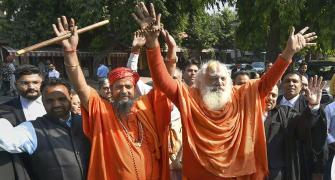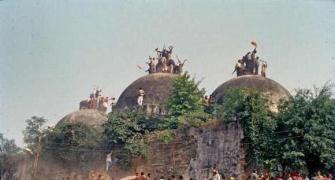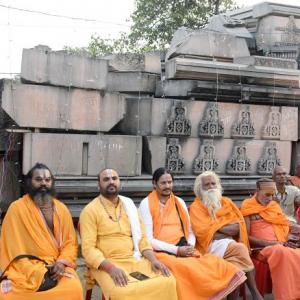Chandrakant Sompura has either planned, designed, built or renovated over a hundred temples in India and abroad.
Vinay Umarji reports.
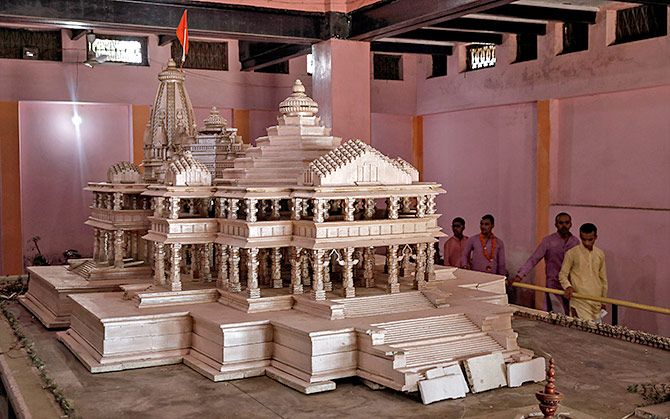
The flood of phone calls to his home office in central Ahmedabad after the Supreme Court verdict paved the way for a Ram temple at the disputed site in Ayodhya has left Chandrakant Sompura both tired and elated.
The verdict has brought the 77-year-old architect, who has designed the model of the temple, into the limelight.
Sompura likes to be called a "temple architect". While he has no formal education in modern architecture, he prides himself for the hands-on training he says he has received in sculpting and temple building according to Vastu Shastra, the traditional Indian system of architecture.
"Everything that I know has been taught to me by my grandfather," says Sompura, recalling his early days with his grandfather Prabhashankar, who worked on designing the vandalised Somnath temple which was rebuilt in the 1940s.
Like his vocation, Sompura's family history, too, is steeped in Hindu mythology. "In his 14-odd books, my grandfather has chronicled how we have been divinely bestowed with the art and craft of sculpting and temple building," he says.
He recounts a mythological story: Chandra (Moon) came down to the western shores of Gujarat with a group of Brahmins to conduct a yagna (fire ritual) to undo the curse of darkness cast on him by Daksha, one of Brahma's sons.
Daksha relented and partially reversed the curse, allowing Chandra to wax and wane every fortnight. Chandra then also urged Daksha to let the Brahmins stay back and practise a new vocation.
"Divinely endowed with sculpting and architectural prowess, this set of Brahmins came to be identified as people belonging to 'Som', another name for Chandra, and were given a 'pur' (dwelling) to stay in Gujarat. That is how Sompuras, the temple builders, came to be," he explains.
As far as he knows, Sompuras have been temple builders for several generations. But when he was studying in high school, Sompura came close to breaking away from the family vocation and would have done so if not for a sudden personal tragedy.
His middle-aged father Balwant Sompura died in a road accident while going to the Badrinath temple in Uttarakhand, the renovation of which he was involved with.
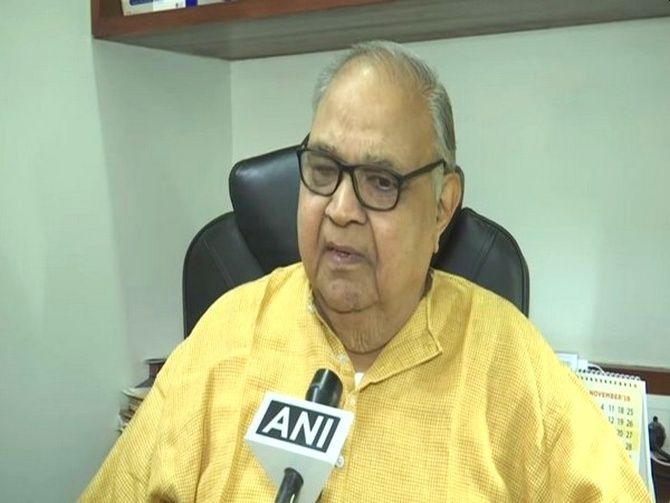
Fearing that the family heritage and skills of sculpting and temple building would be lost forever, his grandfather convinced Sompura to drop out of school and join him on a project.
Soon, Sompura left for Shamlaji in Gujarat's Aravalli district to work on the renovation of the Vishnu-Krishna temple there. Away from home for three months, he learnt the ropes while working on the Shamlaji temple under the mentorship of his grandfather in the 1960s.
Over the years, he became the go-to architect for building or renovating temples, mostly in the western and northern parts of India. From temple trusts to governments and corporate houses, he is sought today by many.
To date, Sompura has either planned, designed, built or renovated over a hundred temples in India and abroad. Among these are the Ambaji temple in Banaskantha and Akshardham temple in Gandhinagar (both in Gujarat), and the Swaminarayan temple in London, which is popularly known as the Neasden temple and is among the largest temples in the world.
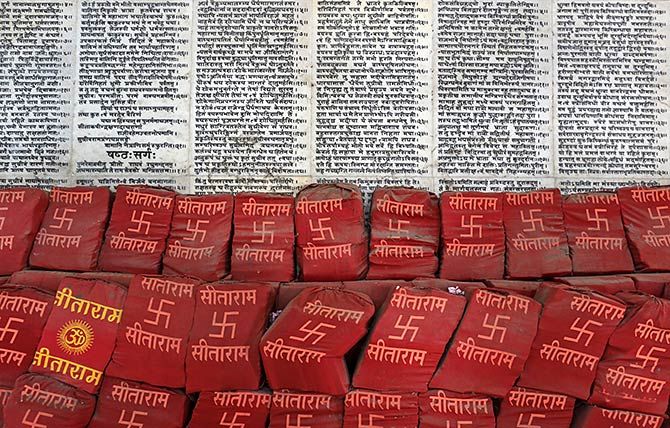
He has built temples for the Birlas, the Ambanis and the Bajaj family. It was one such corporate project -- the Renukeshwar Mahadev temple, which Sompura had built for the Birlas's Hindalco plant in Uttar Pradesh, that caught the attention of Ashok Singhal, then president of the Vishwa Hindu Parishad.
In 1989 Singhal approached Sompura to work on designing a temple for Ram Lalla (the infant Ram) that was being planned at the Hindu god's birthplace in Ayodhya. The temple was to come up at the exact place where the Babri Masjid then stood.
Sompura got down to work. With Singhal briefing him, Sompura worked on designing the temple for the next six months.
This temple would not only highlight the significance of Ram's birthplace, but also be large enough to house a Ram darbar featuring life-size idols of Ram, Sita, Lakshman and Hanuman.
His training in vastu shastra came into play. "According to vastu shastra, the garbh gruh (sanctum sanctorum) is of the utmost importance for Hindus. It is the inner-most part of the temple where the idols are established and it cannot be tampered with in terms of measurement. If the idol signifies the birthplace, then it cannot be built even a few inches away from the exact spot," he says.
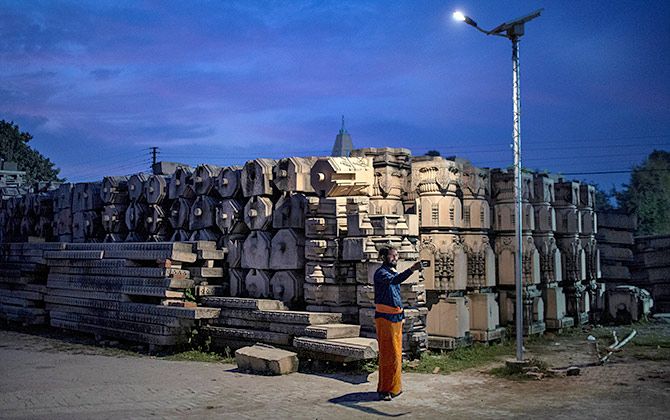
While designing the temple, Sompura not only planned for the main premises, but also assumed that all of the disputed 2.77 acres of land would be allocated for it.
So he also planned the temple compound that would house, among other amenities, an amphitheatre for performing Ram Leela and giving religious discourses.
He has designed the temple as a two-storey complex on a raised platform that is 270 feet long, 145 feet wide and 141 feet high.
All four features typical of a Hindu temple -- the chauki (verandah), nritya mandap (semi-covered porch), gudh mandap (covered porch) and garbha gruh -- are part of the design.
Each of the columns have statues carved on them and the idol in the garbha gruh has been designed in marble.
A peculiarity of the temple compound, which he has planned with four gates, is the southern gate.
"Temples in northern and western India are built according to the Nagar style where the garbh gruh is emphasised by an elevated top above it. The ones in southern India are built in the Dravida style, which emphasises the entrance. Hence, you see the gopuram, or the elevated designs, at the entrances of temples in southern India. To bring unity of both the styles, the southern gate in the Ram temple compound has been designed as a gopuram," says Sompura.
Following another rule of temple building in Hindu tradition, he has used no metal in the design. His design proposes the use of pink sandstone mined from Bansi Paharpur in Rajasthan, the kind that was used at the Akshardham temple.
If the Ram temple is built according to his blueprint, it will require 250,000 to 300,000 cubic feet of sandstone.
"Already 50 per cent of the work is complete with the stones for the main temple being cut, sculpted and kept ready. They just need to be installed," says Sompura.
So, will it be his design that will ultimately shape the proposed Ram temple? "That is up to the government," he says. "I was appointed by the VHP and now the court has ruled that a new government trust needs to be set up. I have offered my services for the temple for free, charging only the cost of material. I will be available again, if called."
Vinay Umarji reports from Ahmedabad for Business Standard.


